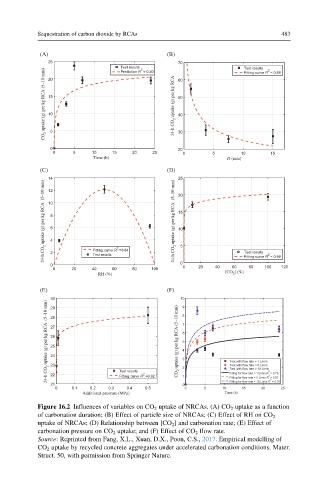Page 535 - New Trends in Eco efficient and Recycled Concrete
P. 535
Sequestration of carbon dioxide by RCAs 483
(A) (B)
25 70
Test results 2 60 Test results 2
CO 2 uptake (g) per kg RCA (5–10 mm) 15 24-h CO 2 uptake (g) per kg RCA 50
Prediction R = 0.80
Fitting curve R = 0.89
20
10
40
0 5 30
20
0 5 10 15 20 25 0 5 10 15
Time (h) D (mm)
(C) (D)
14 20
24-h CO 2 uptake (g) per kg RCA (5–10 mm) 10 8 6 4 24-h CO 2 uptake (g) per kg RCA (5–10 mm) 25
12
15
10
2
t
2 2
Test results
Fitting curve R = 0.98n
0 2 Fitting curve R =0.84 5 0 0 20 40 60 Test results R 100 120
80
0 20 40 60 80 100
2
RH (%) [CO ] (%)
(E) 29 (F) 10 9
24-h CO 2 uptake (g) per kg RCA (5–10 mm) 30 CO 2 uptake (g) per kg RCA (5–10 mm) 8 7 6 5 4 3 Test with flow rate = 1 L/min
28
27
26
25
24
23
Test with flow rate = 10 L/min
Fitting for flow rate = 1 L/min R = 0.78
22
Fitting for flow rate = 5 L/min R = 0.97
Fitting curve R
Fitting for flow rate = 10 L/min R = 0.76
21 Test results 2 =0.92 2 1 0 Test with flow rate = 5 L/min 2 2 2
0 0.1 0.2 0.3 0.4 0.5 0 5 10 15 20 25
Additional pressure (MPa) Time (h)
Figure 16.2 Influences of variables on CO 2 uptake of NRCAs. (A) CO 2 uptake as a function
of carbonation duration; (B) Effect of particle size of NRCAs; (C) Effect of RH on CO 2
uptake of NRCAs; (D) Relationship between [CO 2 ] and carbonation rate; (E) Effect of
carbonation pressure on CO 2 uptake; and (F) Effect of CO 2 flow rate.
Source: Reprinted from Fang, X.L., Xuan, D.X., Poon, C.S., 2017. Empirical modelling of
CO 2 uptake by recycled concrete aggregates under accelerated carbonation conditions. Mater.
Struct. 50, with permission from Springer Nature.

